Exhibition of modern French publications
from the collections of the National Library of Russia
The National Library of Russia and France have old historical and cultural relations. The Library's holdings contains a rich collection of French books and manuscripts, including the famous Voltaire Library.
The New Building of the National Library is hosting events to mark the 2010 Cross Year of Russia and France.
The book exhibition of modern French publications, received by the National Library of Russia throughout the decade 2000-2010, started on 22 March, 2010.
The exhibition features more than 700 French books of prominent French publishers such as "Fayard", "Gallimard", "L' Harmattan", "Albin Michel", "Presses Universitaires du Septentrion", "Presses Universitaires de France", "Payot", "Flammarion", "Armand Colin", "Honore Champion", "Presses de l'Universite de la Sorbonne" and many others. Readers can also look through the books of the Swiss Librairie Droz publishing house and the international Peter Lang Publishing Group, which are related to the French theme.
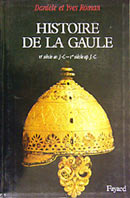 Items on display trace all the main stages in the evolution of French society and French culture.
Items on display trace all the main stages in the evolution of French society and French culture.
The first part of the exhibition focuses on the ancient Gauls and Roman Gaul. In particular, it is worth drawing attention to the integrating work by Daniel and Yves Roman The History of Gaul. 6th cent. BC to 1st cent. AD. Cultural comparison. /Roman D&Y. Histoire de la Gaule. (VI e- s. av. J-C. – I er s. ap. J-C.) Une confrontation culturelle. P. 1997/,
published by Fayard. Book by Jacques Harmand Vercingetorix
/Harmand J. Vercingétorix. P., 1984/ tells the story of the struggle of the Gauls against the Roman conquest. L. Canfora gives an accurate account of the biography of Julius Caesar, the conqueror of Gaul /Canfora L. Jules César: Le dictateur démocrate. P., 2001/. The book by P-M. Duval The Gods of Gaul /Duval P-M. Les dieux de la Gaule.
P.,2002/ focuses on the belief of the ancient Gauls.
Germanic invasions and the fall of the Roman Empire opened a new chapter in the history of France. The Merovingian Kingdom was founded in the late fifth century and lasted until the middle of the eighth century, when it was expanded into the empire of Charlemagne. The ruin of the empire of Charlemagne in 843 caused the emergence of Germanic and French kingdoms and in fact became the starting point in the history of France as an independent state. On display are some books on this era: Carolingian Europe: the 8th-10th Centuries by Jean Leguay and the classic work by Luis Halphen Charlemagne and the Carolingian Empire /Leguay J-P. L’Europe carolingienne: VIIIe – Xe siècles. P., 2002, Halphen L. Charlemagne et l’Empire carolingien. P., 1995/.
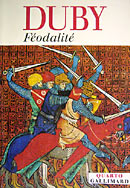 The period of feudal fragmentation is represented at the exhibition by works by the outstanding French medievalists Georges Duby /Duby G. Féodalité. P., 1996/ and Jacques Le Goff /Le Goff J. Un Autre Moyen Âge. P., 2002/, biographies of French kings and political figures of that age, researches on the socio political and ecclesiastical history. Ivan Gobry gives a general description of the state of affairs in France under the Capetian dynasty, which ruled the country more than 300 years from 978 to 1328 /Gobry I. Les Capétiens. P.2001/. In his book, Jean Lemarignier explores, in depth, the social organization of medieval France, the history of public institutions and state agencies /Lemarignier J-F. La France médiévale.Institutions et societé. P., 2000/. France and the Crusades is the subject of the monograph by Jean Flori Peter the Hermit and the First Crusade /Flori J. Piere l’Ermite et la première croisade. P., 1999/. Biography of French kings Philip II Augustus (1180-1223), Louis VIII the Lion (1223-1226), Saint Louis IX (1226-1270) or Eleanor the Duchess of Aquitaine will be of interest to everyone who study this era /Gauthier G. Philippe Auguste. Le printemps de la nation française.P., 2002, Sivery G. Louis VIII le Lion. P., 1995, Richard J. Saint-Louis. Roi
d’une France féodale, soutien de la Terre Sainte. P., 1983, Markale J. Aliénor d’Aquitaine P., 2000/.
The period of feudal fragmentation is represented at the exhibition by works by the outstanding French medievalists Georges Duby /Duby G. Féodalité. P., 1996/ and Jacques Le Goff /Le Goff J. Un Autre Moyen Âge. P., 2002/, biographies of French kings and political figures of that age, researches on the socio political and ecclesiastical history. Ivan Gobry gives a general description of the state of affairs in France under the Capetian dynasty, which ruled the country more than 300 years from 978 to 1328 /Gobry I. Les Capétiens. P.2001/. In his book, Jean Lemarignier explores, in depth, the social organization of medieval France, the history of public institutions and state agencies /Lemarignier J-F. La France médiévale.Institutions et societé. P., 2000/. France and the Crusades is the subject of the monograph by Jean Flori Peter the Hermit and the First Crusade /Flori J. Piere l’Ermite et la première croisade. P., 1999/. Biography of French kings Philip II Augustus (1180-1223), Louis VIII the Lion (1223-1226), Saint Louis IX (1226-1270) or Eleanor the Duchess of Aquitaine will be of interest to everyone who study this era /Gauthier G. Philippe Auguste. Le printemps de la nation française.P., 2002, Sivery G. Louis VIII le Lion. P., 1995, Richard J. Saint-Louis. Roi
d’une France féodale, soutien de la Terre Sainte. P., 1983, Markale J. Aliénor d’Aquitaine P., 2000/.
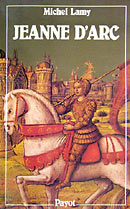 The Hundred Years War (1337-1453), when the country was on the verge of the collapse and loss of independence, occupies a special place in French history. One of the most striking episodes of the war was the struggle against the British under the command of Joan of Arc. Great number of books are devoted to this topic. Some of them can be seen at our exhibition. Among the exhibits are the biography of Joan of Arc by Michel Lamy /Lamy M.Jeanne D’Arc.Histoire vraie et genèse d’un mythe. P., 1987/, biographies of the talented French commander of the second half of the 14th century Bertrand du Guesclin /
Minois G. Du Guesclin. P., 2002/ and King John II the Good(1350-1364) who was abandoned by his knights on the battlefield, but did not flee, and himself fought on and, in the end, was captured by the British /Deviosse J. Jean le Bon. P., 2000/. Also we would like to mention two collections of articles published with the use of reports read at academic conferences at Rouen Images of the Hundred Years War and Images of Joan of Arc /Images de la guerre de Cent Ans. P., 2002 , Images de Jeanne d’Arc. P., 2000/.
The Hundred Years War (1337-1453), when the country was on the verge of the collapse and loss of independence, occupies a special place in French history. One of the most striking episodes of the war was the struggle against the British under the command of Joan of Arc. Great number of books are devoted to this topic. Some of them can be seen at our exhibition. Among the exhibits are the biography of Joan of Arc by Michel Lamy /Lamy M.Jeanne D’Arc.Histoire vraie et genèse d’un mythe. P., 1987/, biographies of the talented French commander of the second half of the 14th century Bertrand du Guesclin /
Minois G. Du Guesclin. P., 2002/ and King John II the Good(1350-1364) who was abandoned by his knights on the battlefield, but did not flee, and himself fought on and, in the end, was captured by the British /Deviosse J. Jean le Bon. P., 2000/. Also we would like to mention two collections of articles published with the use of reports read at academic conferences at Rouen Images of the Hundred Years War and Images of Joan of Arc /Images de la guerre de Cent Ans. P., 2002 , Images de Jeanne d’Arc. P., 2000/.
The unification of France in the late 15th century is reflected in the book by the leading French medievalist Jean Favier, dedicated to Louis XI (1461-1483) /Favier J. Louis XI. P., 2001/. In his memoirs, the historian Philippe de Commines, a contemporary of these events, thoroughly recorded the history of the confrontation of Louis XI with his powerful rival, Charles the Bold the Duke of Burgundy. Mémoires by Philippe de Commines gained extraordinary popularity in the 16th century and became a sort of practical guidance for kings and other political figures. The exhibition presents a new book about this remarkable historian, written by Jean Blachard /Blachard J. Philippe de Commynes. P., 2005/.
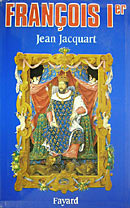 The first half of the 16th century was called "Beautiful Century" in the French historiography. The integrating work by Bernard Quilliet France in the Beautiful 16th Century /Quilliet B. La France du beau XVI -e siècle (1490-1560)/. It was time to strengthen the French monarchy and rise the role of France on the international scene. The major portion of this period of history coincided with the reign of King Francis I (1515-1547), our readers can become familiar with his biography thanks to the book of Jacques Jacquart /Jacquart J. François I er. P., 2003/.
The first half of the 16th century was called "Beautiful Century" in the French historiography. The integrating work by Bernard Quilliet France in the Beautiful 16th Century /Quilliet B. La France du beau XVI -e siècle (1490-1560)/. It was time to strengthen the French monarchy and rise the role of France on the international scene. The major portion of this period of history coincided with the reign of King Francis I (1515-1547), our readers can become familiar with his biography thanks to the book of Jacques Jacquart /Jacquart J. François I er. P., 2003/.
The second half of the 16th century was the complete opposite of the first and went down in history as the era of religious wars (1562-1598). The key figures of this age were Charles IX (1560-1574), Henry III (1574-1589), Henry IV (1589-1610)and Queen Catherine de Medici. Their biographies can be seen at our exhibition /Simonin M. Charles IX. P.,1995, Chevallier P. Henri III roi. P.2002, Cloulas I. Catherine de Medicis. P. 2002/. A number of books on wars between Catholics and Protestants are also available. One of them is a review by Pierre Miquel Religious Wars /Miquel P. Les guerres de religion. P. 2002 /. The other two describe private, but decisive moments in this time. For instance, the book by Denis Crouzet talks about the infamous St. Bartholomew's Day Massacre on August 24, 1572 /Crouzet D. La nuit de la Saint-Barthélemy. P., 1999/, and the book by Jeannine Garrison is about the Edict of Nantes of 1598 which officially marked the end of these wars and granted freedom of conscience to the Protestants /Garrison J. L’Édit de Nantes. Chronique d’une paix attendu. P., 2003/. Worthy of notice among the works, exploring various aspects of French history at that time, are Monique Chatenet's French Court of the 16th Century and Jeanine Garrisson's Protestants in the 16th Century /Chatenet M., La cour de France au XVI s. P., 2002, Garrisson J. Les protestants au XVIe siècle. P., 1997 /.
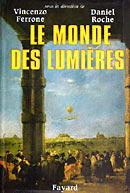 The era of absolutism and its personification in Louis XIV (1643 - 1715) and Louis XV (1715-1774), Cardinals Richelieu and Mazarin took a significant place on display. It was time for consolidation of the royal power and the state, infringement on the traditional rights and privileges of the high nobility, an active colonial policy and a rapid growth of French influence in Europe. At this time, France has turned into one of the leading world powers. French culture flourished. The Age of Enlightenment, the foremost figures of which are Voltaire, Rousseau, Diderot, Montesquieu and others, also reffers to the eighteenth century in France. Voltaire needs special mention because his library is kept in the National Library. The exhibition features several new biographies of the great philosopher by such authors as Jean Orieux and Max Gallo /Orieux J. Voltaire. P., 1999, Gallo M.» Moi,j’écris pour agir». Vie de Voltaire. P., 2008/. However, the Age of Enlightened Absolutism did not last long. Deep contradictions rending the French society, still bounded by innumerable relics of the Middle Ages, led, eventually, the country to revolution. There is a vast literature devoted to this period. Here are just a few items to consider. These, first of all, are two volumes by Pierre Goubert and Daniel Roche The French and the Old Regime issued by the Armand Colin publishing house /Goubert P., Roche D. Les Français et l’ancien régime. T.1-2. P., 2002/ and the fundamental work by Daniel Roche France in the Age of Enlightenment /Roche D. La France des Lumières. P., 2002 /.
The era of absolutism and its personification in Louis XIV (1643 - 1715) and Louis XV (1715-1774), Cardinals Richelieu and Mazarin took a significant place on display. It was time for consolidation of the royal power and the state, infringement on the traditional rights and privileges of the high nobility, an active colonial policy and a rapid growth of French influence in Europe. At this time, France has turned into one of the leading world powers. French culture flourished. The Age of Enlightenment, the foremost figures of which are Voltaire, Rousseau, Diderot, Montesquieu and others, also reffers to the eighteenth century in France. Voltaire needs special mention because his library is kept in the National Library. The exhibition features several new biographies of the great philosopher by such authors as Jean Orieux and Max Gallo /Orieux J. Voltaire. P., 1999, Gallo M.» Moi,j’écris pour agir». Vie de Voltaire. P., 2008/. However, the Age of Enlightened Absolutism did not last long. Deep contradictions rending the French society, still bounded by innumerable relics of the Middle Ages, led, eventually, the country to revolution. There is a vast literature devoted to this period. Here are just a few items to consider. These, first of all, are two volumes by Pierre Goubert and Daniel Roche The French and the Old Regime issued by the Armand Colin publishing house /Goubert P., Roche D. Les Français et l’ancien régime. T.1-2. P., 2002/ and the fundamental work by Daniel Roche France in the Age of Enlightenment /Roche D. La France des Lumières. P., 2002 /.
The exhibition showcases new biography of the well-known French kings Louis XIV, Louis XV, Louis XVI and Queen Marie-Antoinette /Bluche F. Louis XIV.P., 2002, Antoine M. Louis XV. P., 2002, Lever E. Louis XVI. P., 2003, Lever E. Marie-Antoinette. P., 2002/. Books by Michel Carmona and Marie-Catherine Vignal Souleyreau are dedicated to Cardinal Richelieu and his role in French history /Carmona M. La France de Richelieu. P.1998, Vignal Souleyreau M-C. Richelieu ou la quête d’Europe. P., 2008/.
The French Revolution radically changed French society, and affected all of Europe, opening a new period in European history - the period of capitalist development and bourgeois democracy. It was the French Revolution that initiated a dispute about the correct approach to transform society: ‘from above’ through peaceful reforms or ‘from below’ through revolutionary violence. Some publications on this topic are demonstrated at the exibition, namely, the two-volume monograph by Jean Meyer and Jean Poussou The French Revolution /Meyer J. Poussou J-P. La révolution française. T.1-2. Paris 1991/, and the biographies of such revolutionaries as Marat and Robespierre /Coquard O. Jean-Paul Marat. P., 1993, Bessand-Massenet P. Robespierre. L’homme et l’idée. P. 2001.
However, these revolutionary changes were accompanied by bloody terror, lawlessness, and despotism. The landmark event in this regard was the execution of Louis XVI and Marie Antoinette. Not only members of the old aristocracy, but also peasants /remember the uprising in Vandee/ and the revolutionaries themselves met death under wheels of terror. On display are several publications on the politics of terror. Among them is the book by Alain Gerard. "According to the principle of humanity…". Terror and Vendee /Gerard A. «Par principe d’humanité…». La Terreur et la Vandée. P., 1999/.
The Napoleonic era of 1799-1814 became the time of French domination in Europe. By force of arms, Napoleon managed to restore political unity of the West, bringing together dozens of countries and peoples under his rule. The highlight of this section of the exhibition is the two-volume reference source Napoleon's Dictionary, published by Fayard under the editorship of the leading expert on the subject Jean Tulard /Dictionnaire Napoléon sous la direction de Jean Tulard. T.1-2. P., 1999/ and the two-volume monograph by Thierry Lentz A New History of the First Empire /Lentz T. Nouvelle histoire du Premier Empire. T.1-2. P., 2002-2004/
Visitors can also see books that tell of Napoleon's marshals, such as Murat and Lannes /Tulard J. Murat P.,1999, Damamme J-C. Lannes. Maréchal d’Empire. P., 2007/. In a number of books, authors investigate the general situation in the Empire of Napoleon /Tulard J. Napoléon et la noblesse d’Empire.P., 2001 , Martin J-C. Napoléon et l’Europe. Rennes, 2002/. Many exhibs are dedicated to military companies and the battles of the Napoleonic era, including the battles of Austerlitz, Trafalgar and Waterloo /Garnier J., Austerlitz.2 decembre 1805. P., 2005, Monaque R. Trafalgar 21 Octobre 1805. P., 2005. Damamme J-C. La Bataille de Waterloo. P.2001 /. The state of the French army of that time are examined in the fundamental monograph by Alain Pigeard The Army of Napoleon /Pigeard A. L’armée de Napoléon.
P., 2002/. Talleyrand occupies a special place among the politicians of the Napoleonic period. A new biography of the diplomat is also shown at the exhibition /Waresquil E. de. Talleyrand :Le prince immobile. P., 2006/
The main part of the 19th century in France was a period of the battle between a republican and monarchical form of government. During this period, France experienced an industrial revolution and economic growth, the country developed parliamentarism, strengthened civil rights and freedoms.
The nephew of Napoleon I became emperor in 1852 under the name of Napoleon III. His reign, lasted about 20 years, has been called the Second Empire. A characteristic feature of his rule was an attempt to restore the French colonial empire, lost in the 18th century. The exhibition shows the biography of the emperor, written by historian Pierre Milza /Milza P. Napoléon III. P., 2004/, as well as the extensive reference book Dictionary of the Second Empire, published by Fayard /Dictionnaire du Second Empire sous la direction de Jean Tulard.
P., 1995/. However, the unsuccessful war with Prussia in 1870, the course of which readers can learn about from the work by Francois Roth /Roth F. La guerre de 70. P., 2003/, put an end to monarchy in France. The rise of social discontent, caused by this ignominious defeat, was expressed in the Paris Commune. William Surman, Professor of Modern History at the Sorbonne, describes this in his book /Serman W. La commune de Paris. P., 1999/.
The Second Empire was followed by the Third Republic, which existed until 1940. During its 70 years, the republic went through the different stages. The first 40 years were a time of relative prosperity. The country succeeded in breaking the cycle of revolution and counterrevolution. The new regime was founded on the principles of the rights and freedoms for citizens, parliamentarism and other liberal-democratic institutions.
The First World War was a tragic ordeal for France, and although France was among the winners, it paid a terrible price for it. The war of 1914-1918 and its role in France are studied in the two-volume publication by Pierre Vallaud The First World War /Vallaud P. 14-18. La première guerre mondiale. T.1-2. P., 2004/.
The interwar period of 1919-1940 was marked by the struggle between right and left forces, economic turmoil, the rise of fascism, and the erroneous foreign policy that boiled down to the appeasement of Nazi Germany. We would like to draw attention to a few generalized works on this period: The Third Republic by Pierre Miquel, The Longest of the Republics by Jean Mollier, The Sovereign Republic. Political Life in France in the Years of 1870-1940 by Rene Remond /Miquel P. La troisième république. P.,1998, Mollier J-Y. George J. La plus longue des républiqes. 1870-1940. P., 2001, Rémond R. La République souveraine. La vie politique en France 1879-1939. P., 2002 /,as well as a number of biographies of famous political figures of the Third Republic such as Adolphe Thiers, Raymond Poincare, Leon Blum, Edouard Daladier /Guiral P. Adolph Thiers ou de la nécessité en politique. P.,1986, Roth F. Raymond Poincaré. P., 2000, Berstein S. Léon Blum. P., 2006, Réau E. Édouard Daladier. P., 1993/.
The display includes a separate section for France during World War II. The events of May - June 1940, when German troops inflicted a crushing defeat on the French and British armies, are analyzed in the five-volume work by Roger Bruge Soldiers of June 18 /Bruge R. Les combattants du 18 juin. T. 1-5. P., 1989/. Various publications on the German occupation and Vichy regime are also on view at the exhibition. These are the biography of Marshal Petain, whose author is the well-known French historian Marc Ferro /Ferro M. Pétain. P., 1987/ and the book by Annie Lacroix-Riz on the collaboration between French business and the Nazis and Vichy /Lacroix-Riz A. Industriels et banquiers sous l’occupation. La collaboration économique avec le Reich et Vichy. P., 1999/. Many books presented at the exhibition are devoted to the Resistance Movement and its leader General De Gaulle. In particular, we wish to point out the proceedings of the academic conference De Gaulle, the Military Leader. From London's Appeal to the Liberation of Paris: 1940-1944 that took place in Paris in October 2006 /De Gaulle chef de guerre. De l’Appel de Londres à la libération de Paris:1940-1944. P., 2008/.
The second half of the 20th century comprises of two periods that reffer to the Fourth (1946-1958) and the Fifth Republic (1958 to the present day). At this time, all sides of French life has undergone great changes. As a result of a long-term modernization, a new post-industrial information society emerged, and France turned into one of the leading world powers. The French colonial empire began to fall apart, this process was quite painful and accompanied by wars in Indo-China and Algeria. Republics oversaw an era of great social achievements, when the French workers were able to gain sufficient social security coverage. The development of France during the Fourth Republic are described in detail in the four-volume work by Georgette Elzhey History of the Fourth Republic /Elgey G. Histoire de la IV-e république.T.1-4. P., 1993-1997/.
The Fifth Republic was inseparably linked with General de Gaulle, its founder who served as its first President from 1958 to 1969. His doctrine, started during the Second World, was named Gaullism and crucially influenced the politics and government system of modern France. The exhibition features books devoted to this key political figure and statesman of the 20th century /Berstein S. Histoire du gaullisme. P., 2001, Feuilloley P. La France du Général de Gaulle/1958-1969/. P., 2001, Vaïsse M. La grandeur. Politique étrangère du général de Gaulle.P., 1998/.
A number publications cover very recent events. So, Jean-Pierre Jouyet has already offered the review of the presidency of Nicolas Sarkozy who is facing many challenges and especially the global financial crisis /Jouyet J-P. Une presidence de crises. P., 2009/.
See Catalogue of exhibits from the collection of foreign books
Catalogue of exhibits from the collection "The Russian Abroad"
